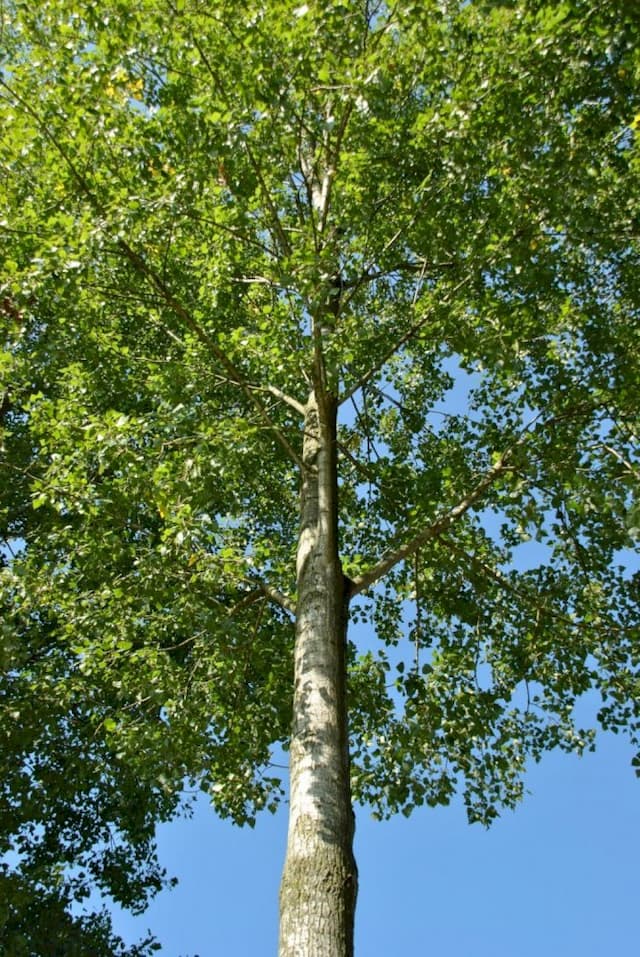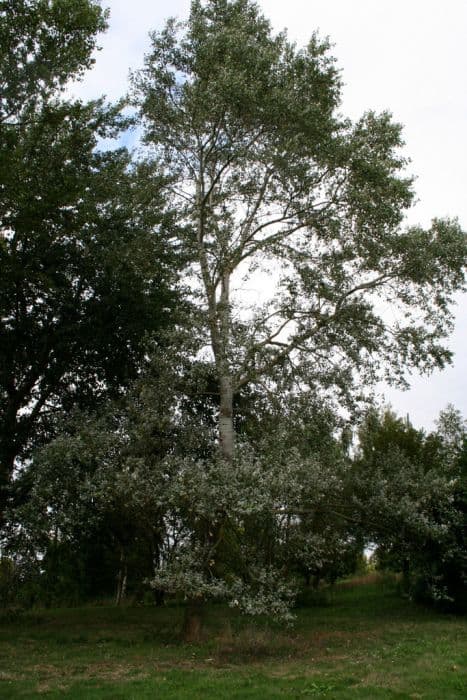Black Poplar Populus nigra subsp. betulifolia

ABOUT
The plant commonly known as Black Poplar is characterized by its dark-colored bark, which over time becomes deeply fissured. This bark provides the tree with a rather rugged texture. The leaves have a unique diamond to triangular shape, with a glossy green upper surface, while the underside is paler. When they flutter in the wind, this two-toned coloration becomes quite noticeable. The edges of the leaves are finely serrated, giving them a slightly toothed appearance. In the spring, the plant produces catkins, which are long, pendulous clusters that contain the flowers. The male catkins are red, while the female catkins are more of a greenish-yellow hue. These catkins appear before the leaves fully unfold. The plant's overall shape tends to be broad and rounded.
About this plant
 Names
NamesFamily
Salicaceae
Synonyms
Black Poplar, Lombardy Poplar
Common names
Populus betulifolia, Populus nigra var. betulifolia.
 Toxicity
ToxicityTo humans
Black poplar is not commonly associated with serious toxicity in humans. There is limited information regarding its toxicity, and it is generally not considered a dangerously poisonous plant. However, like many plants, if parts of it are ingested in large quantities, there might be a risk of stomach upset or other non-specific gastrointestinal complaints. Always exercise caution and avoid ingesting parts of plants that are not established as safe for consumption.
To pets
Black poplar is not widely recognized as a toxic plant to pets. There is a lack of significant data suggesting that it poses a serious risk when ingested by animals such as dogs or cats. However, it is always prudent to prevent pets from consuming plants that are not confirmed to be safe, as individual animals might have sensitivities or allergic reactions. If a pet does consume black poplar and exhibits signs of distress, it is advisable to consult with a veterinarian.
 Characteristics
CharacteristicsLife cycle
Perennials
Foliage type
Deciduous
Color of leaves
Green
Height
100 feet [30 meters]
Spread
40 feet [12 meters]
Plant type
Tree
Hardiness zones
4
Native area
Europe
Benefits
 General Benefits
General Benefits- Shade and Shelter - The plant provides substantial shade due to its large canopy, making it suitable for use in parks and large gardens.
- Erosion Control - Its robust root system helps in stabilizing riverbanks and reducing soil erosion.
- Economic Value - Wood from the plant is used in the timber industry for various products, including plywood and matches.
- Habitat for Wildlife - It serves as a habitat and food source for a variety of wildlife, including insects, birds, and mammals.
- Aesthetic Value - With its lofty stature and striking appearance, it enhances the visual appeal of landscapes.
- Windbreak - It can act as a windbreak, protecting smaller plants and reducing wind speeds in open areas.
- Cultural Significance - The plant has been featured in literature and folklore, representing various cultural symbols.
- Honey Production - It supports bee populations by providing pollen, and the bees, in turn, produce honey.
 Medical Properties
Medical Properties- Anti-inflammatory: Populus nigra subsp. betulifolia has been traditionally used for its anti-inflammatory properties.
- Analgesic: The plant may contain compounds that can relieve pain.
- Antimicrobial: Some studies suggest that extracts of the plant have antimicrobial activities.
- Wound healing: There is evidence that suggests the plant can promote wound healing.
 Air-purifying Qualities
Air-purifying QualitiesThis plant is not specifically known for air purifying qualities.
 Other Uses
Other Uses- The Black Poplar's wood has been traditionally used for making matches due to its capability to ignite easily.
- This species can be used in the creation of agricultural tools, as the wood is strong and can withstand rough use.
- Artists have selected the Black Poplar's lightweight wood for carving sculptures and figurines.
- In some areas, the fibrous bark of the Black Poplar is a source of material for basket weaving crafts.
- The wood has been used for manufacturing veneer, a decorative covering for lesser-quality materials.
- Black Poplar trees can be planted to act as windbreaks, due to their height and robust structure.
- The tree's rapid growth and tolerance of pruning make it suitable for use in privacy hedges or living fences.
- Because of its deep rooting system, Black Poplar is sometimes planted for erosion control on riverbanks and slopes.
- The leaves and twigs of Black Poplar are used as fodder for animals like goats in rural regions.
- Furniture makers have occasionally used Black Poplar wood for lightweight furniture mostly for indoor use.
Interesting Facts
 Feng Shui
Feng ShuiThe Black Poplar is not used in Feng Shui practice.
 Zodiac Sign Compitability
Zodiac Sign CompitabilityThe Black Poplar is not used in astrology practice.
 Plant Symbolism
Plant Symbolism- Life and Death: As Populus nigra subsp. betulifolia, commonly known as Black Poplar, is often found near rivers and has leaves that shake even in the slightest breeze, it symbolizes the constant change between life and death, symbolizing the fragile nature of life.
- Resilience: The resilience of the Black Poplar, able to grow in damp soils and withstand flooding, represents the human ability to endure and adapt to challenging conditions.
- Victory: In some cultures, the towering presence of the Black Poplar is seen as a symbol of victory, its height and stature representing triumph and ascendancy over adversity.
- Hope and Rebirth: With its vigorous growth and capacity to regenerate from damage, the Black Poplar often symbolizes hope, renewal, and the potential for new beginnings after hardship.
 Water
WaterThe Black Poplar requires consistent moisture and should ideally be watered deeply once a week, allowing water to penetrate several inches into the soil. During hot or windy weather, the frequency may need to increase to twice a week. Ensure that the tree receives around 15 to 20 gallons of water per watering session, allowing for thorough hydration of the root zone. Young trees especially benefit from regular watering while establishing. Always check the soil moisture before watering to avoid over-watering, which can lead to root rot.
 Light
LightThe Black Poplar thrives in full sunlight, so it is best to plant it in a location where it will receive at least six hours of direct sunlight per day. This tree is not shade tolerant and will not perform well in shaded or partially shaded areas. Ensuring adequate light is crucial for its growth and overall health.
 Temperature
TemperatureThe Black Poplar can withstand a wide range of temperatures, from as low as -20°F to over 100°F, but it grows best in temperate conditions. Ideally, it should be grown in areas where the average temperature ranges between 50°F and 75°F. The tree is hardy and capable of surviving brief periods of extremes but will thrive in moderate temperatures.
 Pruning
PruningPruning the Black Poplar is necessary to maintain its structural integrity and to remove any damaged or diseased branches. The best time to prune is in the dormant season, usually in late winter before spring growth starts. Pruning should be done annually or biennially, focusing on thinning out crowded branches to allow light and air to penetrate the canopy. Remove any dead or broken limbs to prevent potential hazards and to encourage healthy growth.
 Cleaning
CleaningAs needed
 Soil
SoilThe Black Poplar requires well-drained loamy soil with a neutral to slightly alkaline pH, typically between 6.5 and 8.0. The best soil mix should contain organic matter, and for added drainage, a mixture of sand, loamy garden soil, and compost is suitable for this species.
 Repotting
RepottingBlack Poplars are large trees and are not typically grown in conditions that require repotting. As a landscape tree, it should be planted in the ground where it can reach full size.
 Humidity & Misting
Humidity & MistingBlack Poplars can tolerate a wide range of humidity levels; they thrive in outdoor environments with natural atmospheric humidity and do not require specific humidity adjustments.
 Suitable locations
Suitable locationsIndoor
Growing Black Poplar indoors is not feasible.
Outdoor
Plant in full sun and moist, well-drained soil.
Hardiness zone
3-9 USDA
 Life cycle
Life cycleThe life cycle of the Black Poplar (Populus nigra subsp. betulifolia) begins with seed dispersal, typically by wind or water, which occurs in the spring shortly after the seeds are released from the catkins. Germination follows when conditions are moist and warm, leading to the emergence of the seedlings that quickly grow into saplings. As the saplings mature, the Black Poplar enters a rapid growth phase, developing a deep root system and a tall, straight trunk, with the tree becoming sexually mature within 10-15 years. Reproduction in mature trees involves the production of catkins that are either male or female on separate trees (dioecious), with pollination largely dependent on the wind. After fertilization, seeds develop and are again dispersed by wind or water, completing the reproductive cycle. Throughout its life, the Black Poplar may also reproduce asexually through root suckers, contributing to the formation of clonal colonies.
 Propogation
PropogationPropogation time
Spring to early summer
Propogation: The most popular method of propagating the Black Poplar or Populus nigra subsp. betulifolia is through hardwood cuttings. This technique typically takes place in late fall or early winter, when the tree is dormant. The cuttings, consisting of last season's growth, should be about 12 to 18 inches (30 to 46 centimeters) in length and at least half an inch (approximately 1.3 centimeters) in diameter. These cuttings are then placed directly into the ground where they are to grow, ensuring that at least two-thirds of the cutting's length is submerged in soil to allow for sufficient root development. The soil should be kept moist until the cuttings have established a healthy root system, which can be determined by the emergence of new growth.









